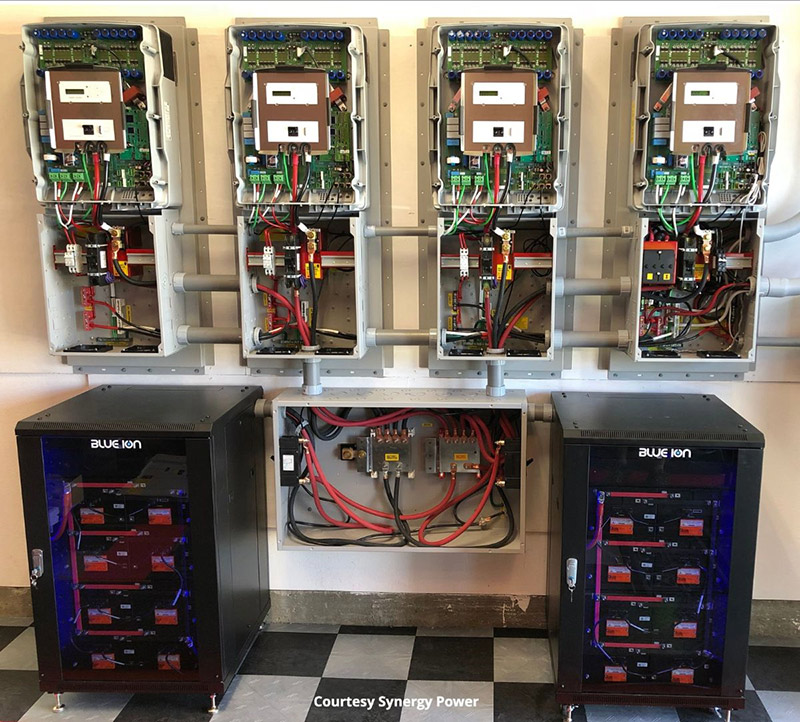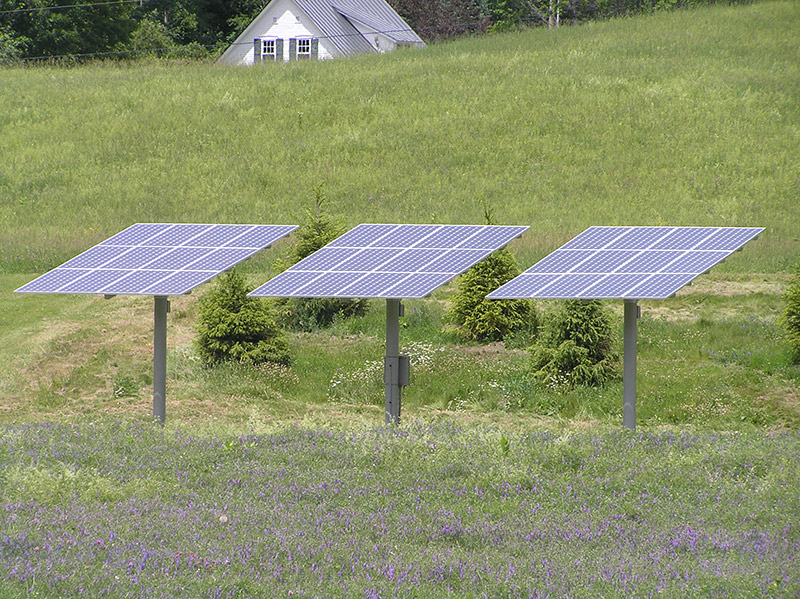
Grid-Tied Solar Systems
 A grid connected renewable energy system receives back-up power from a utility’s grid when the system is not producing enough power and supplies locally generated power to the grid when excess power is available.
A grid connected renewable energy system receives back-up power from a utility’s grid when the system is not producing enough power and supplies locally generated power to the grid when excess power is available.
The explosive growth in solar over the past few years is almost entirely in the grid-tie market. One of the key drivers of the explosion in grid-tie solar is the advent of net metering policies. By law, utilities are required to purchase back solar-generated electricity from your grid-tie system, and furthermore, they must pay for your electricity at the same retail rate they charge you for their own electricity!
Under this arrangement, your electric meter will spin forward when you are using more power than you are generating, and spin backward when you are making more power than you are using.
You are only billed for the difference, or the net power, used.
Depending on your site conditions, energy usage patterns, and system size, the renewable energy generated electricity will provide anywhere from 25-100% of your annual power needs; 40-80% is typical. That means that for the life of your system you won’t need to worry about utility rate hikes for that portion of your electricity!
There are two types of Grid-Tied systems: Basic Intertie and Intertie with battery backup.
The main components of a basic grid-connected, net metered renewable energy system include:
- Electricity Generation equipment including PV solar modules, wind turbines, micro-hydro turbines, and even fossil fuel backup generators.
- AC and DC Disconnects
- DC to AC Inverters with automatic grid disconnects
- Net Metering Equipment
Generally there are three types of electricity generation sources used in typical renewable energy systems: solar PV, Wind turbines, and Micro-hydro turbines.
Solar PV panels typically have a manufacturer’s warranty that guarantees power production for 25 years. However, many experts expect PV panels to work well for 30 to 40 years or longer. In fact, more than 95% of the PV panels in use since the ‘70s are still producing power!
Unlike the other methods of generating electricity, PV power systems have no moving parts. This translates into both long life and very low system maintenance. Generally wind and micro-hydro can be more economical for larger systems or to supplement PV, but require more maintenance over the life of the system.
Additionally, to be efficient and economical, wind and micro-hydro systems have very specific site requirements.
Very minimal additional equipment is required for the basic intertie system including AC and DC disconnects, grid-tie inverter, wiring and fusing.
For this reason the basic grid-tied system is most economical. In the event of a power outage, the inverter automatically and instantaneously disconnects from the utility.
In this situation, any locally generated power is lost. For this reason, many homeowners rely on a typical backup generator system to supply critical loads.
Read more about system components.
Grid-Tied Solar Electric Systems with Battery Back-up
 Grid-Tied solar electric systems with battery back-up are similar to the basic grid-tied systems, with the added advantage of continuing to produce power during grid outages. Due to the added equipment and complexity, these systems are significantly more expensive. However, they do provide the comfort and security of continuing to produce and provide power during blackouts. The basic components of a grid-connected with battery backup, net metered renewable system are shown here.
Grid-Tied solar electric systems with battery back-up are similar to the basic grid-tied systems, with the added advantage of continuing to produce power during grid outages. Due to the added equipment and complexity, these systems are significantly more expensive. However, they do provide the comfort and security of continuing to produce and provide power during blackouts. The basic components of a grid-connected with battery backup, net metered renewable system are shown here.
These systems are similar to the basic system with the addition of a bank of batteries and battery charging equipment.
Batteries can involve significant maintenance and costs. In the event of a power outage, the inverter automatically and instantaneously disconnects from the utility. The inverter then uses the battery bank to power your home or office, while the electricity generating source(s) continue to recharge the batteries, so no locally generated power is lost. The system will automatically reconnect to the utility when power returns.
Is PV Right for Me?
The professional system designers at RES-TEC can design a system to meet any electrical demand, no matter how large or small.
If you would like to further explore your options with regard to solar electrical systems simply give us a call or send an email, Contact Us. We will schedule an appointment to visit your site in order to perform a thorough evaluation of your potential solar resource.
The design team at RES-TEC will generate a basic system design, and provide a proposal showing the estimated system cost, expected annual system performance estimate, carbon foot-print reduction calculation, and system pay-back times.
Currently, there are very substantial incentives at both the state and federal level to significantly reduce your costs.
We provide this service at no charge to our valued customers and look forward to working with you to bring more green energy to the Green Mountains!
CONTACT US TO LEARN MORE TODAY
Please fill out and submit the Free Estimate Form to receive our competitive solar panel quote. Once we receive your request, we will contact you with further assistance.
We will not give or sell your information to any 3rd party.
